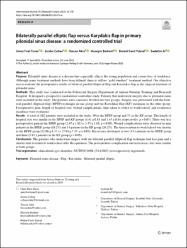| dc.contributor.author | Turan, Umut Fırat | |
| dc.contributor.author | Çoban, Serdar | |
| dc.contributor.author | Akın, Tezcan | |
| dc.contributor.author | Berkem, Hüseyin | |
| dc.contributor.author | Yüksel, Bülent Cavit | |
| dc.contributor.author | Er, Sadettin | |
| dc.date.accessioned | 2023-12-28T08:32:37Z | |
| dc.date.available | 2023-12-28T08:32:37Z | |
| dc.date.issued | 2023 | en_US |
| dc.identifier.citation | Turan, U. F., Coban, S., Akin, T., Berkem, H., Yuksel, B. C., & Er, S. (2023). Bilaterally parallel elliptic flap versus Karydakis flap in primary pilonidal sinus disease: a randomized controlled trial. International journal of colorectal disease, 38(1), 176. https://doi.org/10.1007/s00384-023-04475-w | en_US |
| dc.identifier.uri | https://hdl.handle.net/20.500.12900/276 | |
| dc.description.abstract | PurposePilonidal sinus disease is a disease that especially affects the young population and causes loss of workforce. Although many treatment methods have been defined, there is still no "gold standard" treatment method. Our objective was to evaluate the postoperative results of bilateral parallel elliptical flap and Karydakis flap in the surgical treatment of pilonidal sinus.MethodsThis study was conducted at the Colorectal Surgery Department of Ankara Numune Training and Research Hospital. It designed a prospective randomized controlled study. Patients that underwent surgery due to pilonidal sinus were included in the study. The patients were randomly divided into two groups. Surgery was performed with the bilateral parallel elliptical flap (BPEF) technique in one group and the Karydakis flap (KF) technique in the other group. Postoperative pain, length of hospital stay, wound complications, time taken to return to work/school, and recurrence incidence were evaluated.ResultsA total of 102 patients were included in the study, 49 in the BPEF group and 53 in the KF group. The length of hospital stay was similar in the BPEF and KF groups (1.41 & PLUSMN; 0.81 and 1.45 & PLUSMN; 0.84, respectively; p > 0.05). There was less postoperative pain in the BPEF group (2.47 & PLUSMN; 1.02 vs 3.57 & PLUSMN; 1.10, p < 0.05). Wound complications were observed in nine patients in the BPEF group (18.2%) and 14 patients in the KF group (26.2%). The time to return to work/school was shorter in the BPEF group (21.06 & PLUSMN; 6.37 vs 27.04 & PLUSMN; 7.45; p < 0.05). Recurrence developed in two (4%) patients in the BPEF group and three (5.6%) patients in the KF group (p > 0.05).ConclusionsThe patients who underwent surgery with the bilateral parallel elliptical flap technique had less pain and a shorter time to return to work/school after the operation. The postoperative complication and recurrence rates were similar in both groups. | en_US |
| dc.language.iso | eng | en_US |
| dc.publisher | Springer | en_US |
| dc.relation.isversionof | 10.1007/s00384-023-04475-w | en_US |
| dc.rights | info:eu-repo/semantics/openAccess | en_US |
| dc.subject | İkili paralel eliptik | en_US |
| dc.subject | Bilateral parallel elliptic | en_US |
| dc.subject | Kapak | en_US |
| dc.subject | Flap | en_US |
| dc.subject | Karydakiler | en_US |
| dc.subject | Karydakis | en_US |
| dc.subject | Pilonidal sinüs hastalığı | en_US |
| dc.subject | Pilonidal sinus disease | en_US |
| dc.title | Bilaterally parallel elliptic flap versus Karydakis flap in primary pilonidal sinus disease: a randomized controlled trial | en_US |
| dc.type | article | en_US |
| dc.department | İstanbul Atlas Üniversitesi, Tıp Fakültesi, Cerrahi Tıp Bilimleri Bölümü | en_US |
| dc.authorid | Umut Fırat Turan / 0000-0001-7135-113X | en_US |
| dc.contributor.institutionauthor | Turan, Umut Fırat | |
| dc.identifier.volume | 38 | en_US |
| dc.identifier.issue | 1 | en_US |
| dc.relation.journal | International Journal of Colorectal Disease | en_US |
| dc.relation.publicationcategory | Makale - Uluslararası Hakemli Dergi - Kurum Öğretim Elemanı | en_US |

















